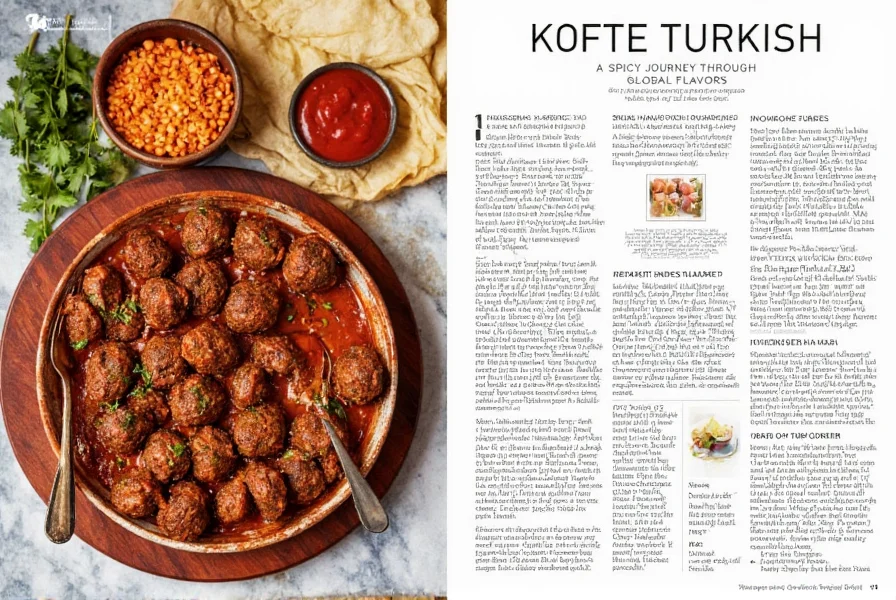Kofte Turkish: A Spicy Journey Through Global Flavors
Spices are the heartbeat of global cuisine, and nowhere is that more evident than in the rich, aromatic world of kofte turkish. This beloved dish, with its meaty texture and bold seasoning, has transcended borders to become a staple in kitchens across the globe. Whether you're a seasoned spice connoisseur or just starting your culinary adventure, this article will guide you through the history, flavors, and practical tips for mastering kofte turkish.
Table of Contents
- Introduction to Kofte Turkish
- The Flavor Profile of Kofte Turkish
- Global Connections and Cultural Significance
- Essential Cooking Tips for Kofte Turkish
- Buying Guide: Finding the Best Ingredients
- Conclusion
Introduction to Kofte Turkish
Kofte turkish, also known as Turkish meatballs, are a classic dish that has been enjoyed for centuries. Made from ground meat (usually beef or lamb), mixed with herbs, spices, and sometimes breadcrumbs, these little bundles of flavor are a staple in Turkish cuisine. But what makes them so special? Let's dive into the world of kofte turkish and uncover its secrets.

The Flavor Profile of Kofte Turkish
The magic of kofte turkish lies in its flavor profile. These meatballs are typically seasoned with a mix of garlic, onions, cumin, paprika, and sometimes sumac or mint. The result is a complex, savory taste that can range from mildly spicy to deeply aromatic. The texture is also a key component—crispy on the outside, juicy and tender inside.
Here’s a quick comparison of the flavor profiles of different types of kofte:
| Dish | Flavor Profile | Common Spices |
|---|---|---|
| Kofte Turkish | Savory, slightly spicy, aromatic | Cumin, paprika, garlic, onion |
| Kofte Persian | Rich, nutty, herbaceous | Saffron, rose water, barberries |
| Kofte Armenian | Tangy, smoky, hearty | Sumac, cinnamon, tomato paste |

Global Connections and Cultural Significance
Kofte turkish isn’t just a Turkish dish—it’s a symbol of cultural exchange and culinary tradition. In countries like Greece, Armenia, and even parts of the Middle East, variations of kofte have evolved over time, each reflecting local ingredients and customs. For example, in Greece, they’re often served with a side of tzatziki, while in Iran, they might be paired with rice and a tangy yogurt sauce.
This dish is also a favorite at family gatherings, festivals, and celebrations. It’s not just about the food; it’s about bringing people together. As one of the most iconic dishes in Turkish cuisine, kofte turkish holds a special place in the hearts of many.

Essential Cooking Tips for Kofte Turkish
If you're eager to try making kofte turkish at home, here are some practical tips to ensure success:
- Use fresh ingredients: Freshly ground meat and high-quality spices make all the difference in the final taste.
- Don't overmix: Overmixing can lead to dense, tough meatballs. Mix just until the ingredients are combined.
- Choose the right pan: A non-stick skillet or cast iron pan works best for cooking kofte turkish, ensuring even browning without sticking.
- Season generously: Don’t be shy with the spices. They’re the soul of the dish.
- Let it rest: After cooking, let the kofte turkish rest for a few minutes before serving. This allows the juices to redistribute and improves the texture.
For those who want to elevate their kofte turkish experience, consider adding a touch of lemon juice or a drizzle of olive oil before serving. These small additions can enhance the flavor and give your dish an extra layer of complexity.

Buying Guide: Finding the Best Ingredients
When it comes to making authentic kofte turkish, the quality of your ingredients matters. Here’s a breakdown of what to look for when shopping:
Meat
Choose ground beef or lamb with a good fat content (around 20% fat) for optimal juiciness. If possible, opt for grass-fed or organic options for a richer flavor.
Spices
Look for whole spices like cumin seeds, paprika, and garlic powder. Whole spices retain their potency longer and can be toasted for added depth. You can also find pre-mixed spice blends, but making your own gives you more control over the flavor.
Herbs and Vegetables
Onions and garlic are essential. Fresh herbs like parsley or dill can add a nice herbal note. Some recipes may include breadcrumbs or eggs to bind the mixture, so check the label if you’re buying pre-made mixes.
Additional Tools
Invest in a good mixing bowl, a meat grinder (if you prefer homemade mince), and a reliable kitchen scale for accurate measurements. A good knife set will also help with chopping and slicing ingredients.
Here’s a quick summary of recommended products for making kofte turkish:
| Product | Features | Best For |
|---|---|---|
| Ground Beef (20% Fat) | High-quality, lean cut with enough fat for moisture | Traditional kofte turkish recipes |
| Whole Cumin Seeds | Can be toasted for enhanced aroma | Homemade spice blends |
| Non-Stick Skillet | Ensures even cooking and prevents sticking | Perfect for frying kofte turkish |
| Meat Grinder | Allows you to grind your own meat for freshness | Customizing the texture of your kofte |

Conclusion
Kofte turkish is more than just a dish—it’s a celebration of culture, flavor, and tradition. Whether you’re cooking it for a family meal, a dinner party, or simply for yourself, this recipe offers endless possibilities for creativity and enjoyment. By understanding its origins, flavor profile, and cooking techniques, you’ll be well on your way to mastering this beloved Turkish staple.
So next time you’re craving something hearty and flavorful, reach for the spices and bring the taste of Turkey to your table. With a little practice and a lot of passion, you’ll soon be making kofte turkish like a pro.










 浙公网安备
33010002000092号
浙公网安备
33010002000092号 浙B2-20120091-4
浙B2-20120091-4